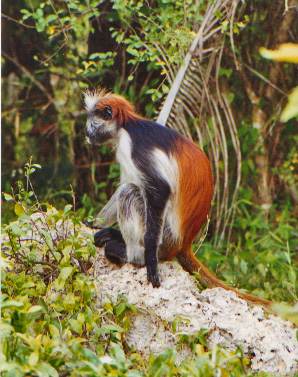Zanzibar Red Colobus (Piliocolobus kirkii) - Wiki Zanzibar Red Colobus
From Wikipedia, the free encyclopedia
[Photo] Zanzibar Red Colobus (Piliocolobus kirkii). These monkeys are unique to Zanzibar. Date September 11, 2006 at 21:03. Author colin houston from Kilmacolm, Scotland http://www.flickr.com/people/57705427@N00
The Zanzibar Red Colobus (Piliocolobus kirkii) is a species of red colobus monkey endemic to Unguja, the main island of the Zanzibar archipelago, off the coast of Tanzania. It is also known as Kirk's Red Colobus after Sir John Kirk (1832-1922), the British Resident of Zanzibar who first brought it to the attention of zoological science. It is now classified as an endangered species and in the mid-1990s was adopted as the flagship species for conservation in Zanzibar.
Description
This Old World monkey has a coat that ranges from dark red to black, accented with a black stripe along the shoulders and arms, and a pale underside. Its black face is crowned with long white hair, and features a distinguishing pink mark on its lips and nose. Also, the Zanzibar Red Colobus has a long tail used for balancing. Females have little difference in their body size and colour from their male counterparts, and usually outnumber the males in their groups.
Behaviour
The groups consist of up to four adult males and many adult females. Young of varying ages also are incorporated in the group. The number of monkeys in a group can range from thirty to fifty individuals. The monkeys are very social animals, and can often be observed playing and grooming during the rest periods between meals.
Feeding is also a group activity. It begins to feed in the morning, and are more active during the cooler parts of the day. Loud calls from males indicate the group is ready to move to another tree to feed. This monkey usually eat leaves, leaf shoots, seeds, flowers, and unripe fruit. It is one of the few species that do not eat ripe fruits; it has a four-chambered stomach, which cannot digest the sugars contained in the fruits. It also consumes charcoal, which is believed to aid their digestion of the toxins in the leaves.
The Zanzibar Red Colobus prefers drier areas over wet ones, such as coastal thickets and coastal rag scrub, but can also be found in agricultural areas and in mangrove swamps. When found in agricultural areas, the monkeys are more used to humans and come closer to the ground.
http://en.wikipedia.org/wiki/Zanzibar_Red_Colobus
| The text in this page is based on the copyrighted Wikipedia article shown in above URL. It is used under the GNU Free Documentation License. You may redistribute it, verbatim or modified, providing that you comply with the terms of the GFDL. |
